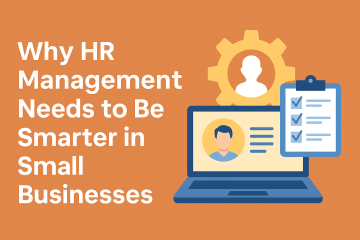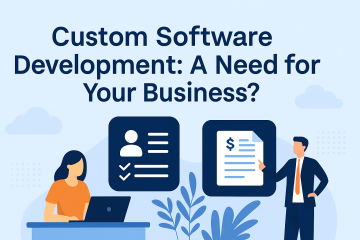In today’s competitive business environment, companies need to maximize efficiency to stay ahead of the curve. One of the most effective ways to achieve this is by adopting a Human Resource Management System(HRMS). This advanced technology streamlines HR processes, reduces administrative burdens, and allows HR teams to focus on strategic goals that align with business growth. In this blog, we’ll explore how a Human Resource Management System can significantly improve efficiency and support businesses in managing their workforce more effectively.
What Is a Human Resource Management System?
A Human Resource Management System (HRMS) is an integrated software solution designed to manage and automate various HR functions. These include recruitment, employee data management, payroll, benefits administration, performance management, and more. HRMS is often referred to as HR software, and it combines essential HR tasks in a centralized system that can be accessed easily by HR teams, managers, and even employees.
Key Benefits of a Human Resource Management System
A Human Resource Management System can bring several advantages to an organization, leading to increased efficiency and productivity across multiple departments. Here are some of the key ways an HRMS can streamline operations:
1. Automated Administrative Tasks
One of the most significant advantages of an HRMS is its ability to automate repetitive and time-consuming administrative tasks. For example, HR teams can automate employee attendance tracking, leave management, and payroll processing. This reduces the manual effort involved and minimizes the risk of errors. When tasks such as generating payslips or updating employee records are automated, HR staff can focus on more strategic responsibilities.
2. Centralized Data Management
With an HRMS, all employee data is stored in a centralized system. This allows HR teams to easily access and update information as needed, such as personal details, job titles, compensation, performance reviews, and more. Centralized data management ensures that records are accurate, up-to-date, and easily accessible, leading to improved efficiency in managing employee information.
3. Improved Recruitment and Onboarding
HRMS solutions also streamline the recruitment process. They enable HR teams to post job openings, track applications, and evaluate candidates more effectively. An HRMS can help with scheduling interviews, sending automated notifications to applicants, and even conducting background checks. This ensures a smooth recruitment process and helps businesses hire qualified candidates quickly.
Moreover, the HR management software simplifies onboarding for new employees by automating tasks such as document submission, benefits enrollment, and training schedules. A well-organized onboarding process not only boosts efficiency but also helps new hires feel welcomed and integrated into the company faster.
4. Performance Management and Employee Development
A Human Resource Management System can help companies track employee performance, set goals, and provide ongoing feedback. Managers can easily monitor key performance indicators (KPIs), assess employee strengths and weaknesses, and identify areas for improvement. The system can also facilitate performance reviews and track professional development initiatives.
By having a clear picture of employee performance, HR teams can ensure that employees receive the support they need to grow within the organization. An efficient HR management software can even provide tools for training and skill development, helping businesses maintain a skilled workforce.
5. Better Payroll and Benefits Administration
Payroll processing can be one of the most complex and time-consuming tasks for HR teams. With an HRMS, businesses can automate payroll calculations, tax deductions, and benefits management. The system ensures that employees are paid accurately and on time, reducing the likelihood of errors and compliance issues.
Additionally, HR management software can help employees manage their benefits, such as health insurance, retirement plans, and vacation days. By providing easy access to this information, the HRMS reduces the need for HR teams to field routine inquiries, allowing them to focus on more critical tasks.
6. Enhanced Compliance Management
Maintaining compliance with labor laws and regulations is a significant responsibility for HR departments. An HRMS helps businesses stay compliant by automatically updating legal requirements, such as tax regulations and labor laws. The system can also generate reports for auditing purposes, helping companies stay on top of necessary documentation and deadlines.
Compliance features in HR management software reduce the risk of legal issues, fines, and penalties. This is especially valuable for organizations with complex regulations or those operating in multiple regions with different legal requirements.
7. Improved Communication and Collaboration
Effective communication is key to any organization’s success. An HRMS improves communication by allowing HR teams, managers, and employees to collaborate easily. Whether it’s submitting leave requests, communicating policy changes, or accessing important documents, an HRMS provides a central platform for interaction.
The system can also streamline internal communication by allowing managers to share important updates with employees and track responses. This fosters a more collaborative work environment, which is essential for enhancing overall efficiency.
8. Data-Driven Insights for Better Decision Making
A well-implemented HRMS provides valuable insights into workforce metrics, such as turnover rates, employee engagement, and training effectiveness. These insights help HR teams make more informed decisions regarding recruitment, compensation, benefits, and employee development.
HR management software can also generate real-time reports, enabling management to quickly assess and address potential issues before they escalate. Data-driven decision-making improves business operations and increases overall efficiency.
How a Human Resource Management System Supports HR Teams
HR teams play a vital role in shaping the company culture, managing talent, and driving employee engagement. By automating routine tasks and offering greater visibility into workforce data, an HRMS empowers HR teams to focus on high-impact activities that align with business goals. For example, HR teams can spend more time developing employee engagement strategies or working on initiatives to improve company culture rather than dealing with administrative work.
Furthermore, HR management software supports remote work environments by allowing employees and HR professionals to access important information from any location. Whether employees need to request time off or HR teams need to update payroll information, the system provides a flexible solution that accommodates various work styles and situations.
How to Choose the Right Human Resource Management System
When selecting an HRMS, businesses should consider factors such as ease of use, scalability, integration with other systems, and the specific features required to meet their HR needs. Look for a solution that offers customization options, so it can adapt to the unique needs of your organization. Additionally, ensure that the system complies with industry standards and offers the security necessary to protect sensitive employee data.
Conclusion
A Human Resource Management System is a powerful tool that can significantly boost efficiency in HR operations. By automating administrative tasks, improving communication, and providing valuable insights, an HRMS enables HR teams to focus on more strategic initiatives. The benefits of using HR management software include improved recruitment, streamlined payroll processing, enhanced employee development, and better compliance management.
Implementing a well-designed Human Resource Management System allows businesses to better manage their workforce, improve decision-making, and achieve their long-term objectives more efficiently. If you’re looking to improve HR processes, investing in an HRMS is a step in the right direction.



0 Comments